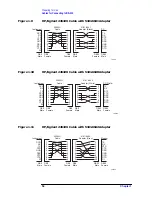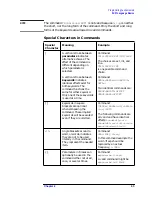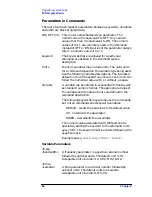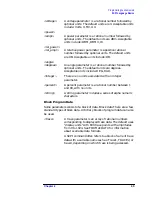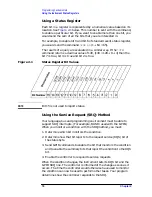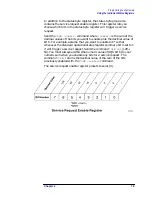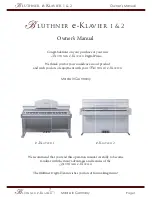
66
Chapter 2
Programming Fundamentals
SCPI Language Basics
<bit_pattern> A bit pattern parameter specifies a series of bits rather
than a numeric value. The bit series is the binary
representation of a numeric value. There are no units.
Bit patterns are most often specified as hexadecimal
numbers, though octal, binary or decimal numbers may
also be used. In the SCPI language these numbers are
specified as:
• Hexadecimal, #Hdddd or #hdddd where ‘d’
represents a hexadecimal digit 0 to 9, or a to f.
• Octal, #Odddddd or #odddddd where ‘d’ represents
an octal digit 0 to 7.
• Binary, #Bdddddddddddddddd or
#bdddddddddddddddd where ‘d’ represents a 1 or 0.
<arbitrary block data> This parameter type consists of a block of data
bytes. The first information sent in the block is an
ASCII header beginning with #. The header can be used
to determine how many bytes are in the data block.
There are no units.
For example, suppose the header is #512320.
• The first digit in the header (5) tells you how many
additional digits/bytes there are in the header.
• The 12320 means 12 thousand, 3 hundred, 20 data
bytes follow the header.
• Divide this number of bytes by your current data
format (bytes/point), either 8 (for real64), or 4 (for
real32). For this example, if you’re using real64 then
there are 1540 points in the block.
Summary of Contents for E4406A VSA Series
Page 4: ...4 ...
Page 59: ...59 2 Programming Fundamentals ...
Page 124: ...124 Chapter2 Programming Fundamentals Using the LAN to Control the Analyzer ...
Page 125: ...125 3 Programming Examples ...
Page 164: ...164 Chapter3 Programming Examples Using Java Programming Over Socket LAN ...
Page 165: ...165 4 Programming Command Cross References ...
Page 379: ...379 6 Error Messages ...
Page 412: ...412 Chapter6 Error Messages Error Message Descriptions ...



